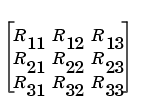

| SimMechanics |   |
Convert a 3-by-3 rotation matrix to an equivalent VRML form of rotation axis and angle
Library
Description
A rotation with respect to an initial orientation has many equivalent representations. A common and important one is the 3-by-3 orthogonal rotation matrix R, where R-1 = RT and RTR = RRT = 1, the 3-by-3 identity matrix. Another important representation is the combination of rotation axis (a unit vector n) and angle of rotation  about that axis. The sign of rotation follows the right-hand-rule.
about that axis. The sign of rotation follows the right-hand-rule.
The RotationMatrix2VR block converts the 3-by-3 rotation matrix representation of orientation to its equivalent representation as a rotation axis and angle about that axis, the form used in Virtual Reality Modeling Language (VRML) and the Virtual Reality Toolbox for orienting bodies. The input and output signals are bundled Simulink signals.
The most common use of rotations is to represent the orientation of a body with respect to some coordinate system (CS) axes.
Dialog Box and Parameters
The dialog box has no active areas.
Representations of rotation signals
The rotation matrix R has the form:

The input signal to the RotationMatrix2VR block is the R matrix components passed column-wise and bundled into a single 9-component Simulink signal: [R11 R21 R31 R12 ...].
The output signal is the equivalent rotation represented as the axis of rotation, a unit vector n = (nx,ny,nz), with
and the angle of rotation  about that axis. The sign of the rotation follows the right-hand rule. The output signal is bundled into a single 4-component Simulink signal:
about that axis. The sign of the rotation follows the right-hand rule. The output signal is bundled into a single 4-component Simulink signal:
[nx ny nz 
].
See Also
See entries on axis-angle rotation, Euler angles, quaternion, and rotation matrix in Glossary for more details on representing body orientation.
For more on virtual reality and VRML, see the Virtual Reality Toolbox User's Guide.
 | Revolute-Spherical | Screw |  |